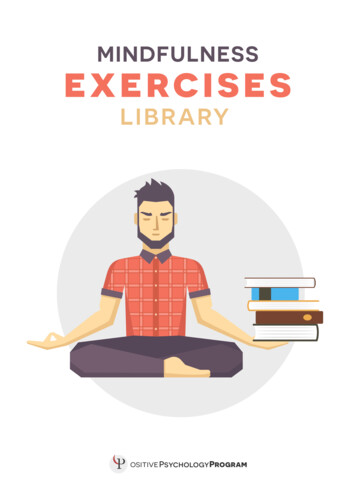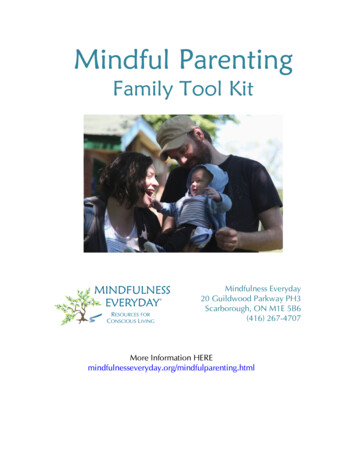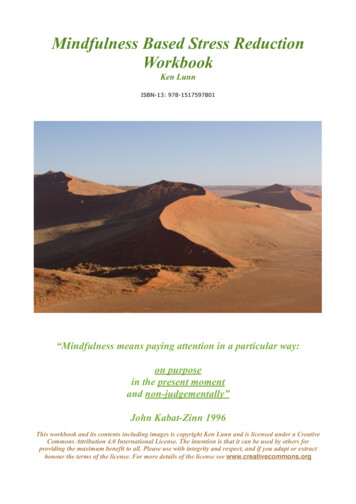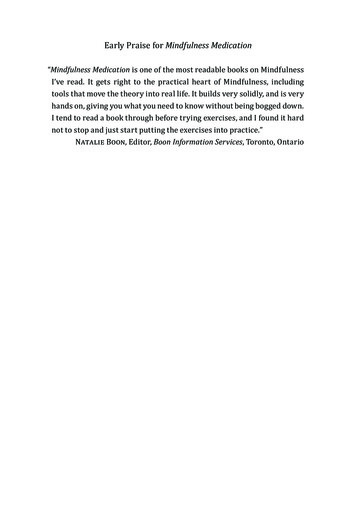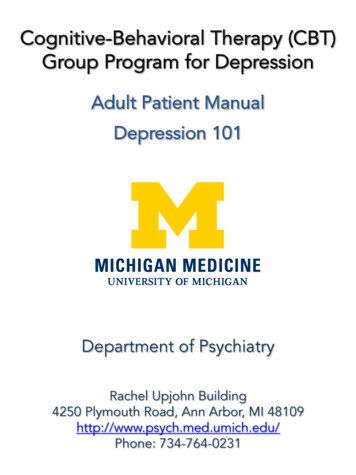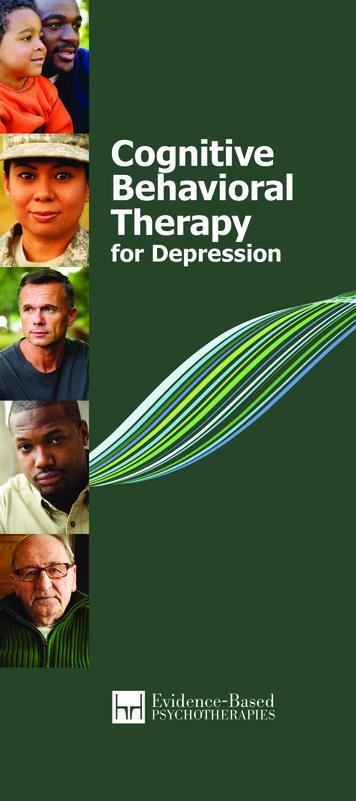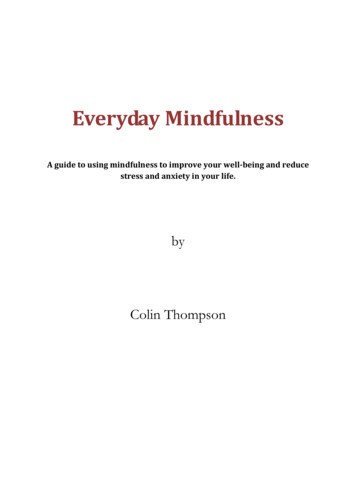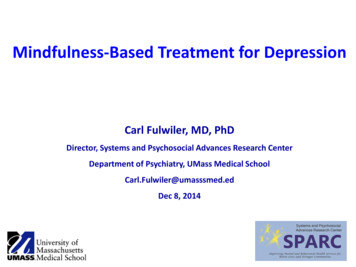
Transcription
Mindfulness-Based Treatment for DepressionCarl Fulwiler, MD, PhDDirector, Systems and Psychosocial Advances Research CenterDepartment of Psychiatry, UMass Medical SchoolCarl.Fulwiler@umasssmed.edDec 8, 2014
Disclosure Grant support: NIH Grant number R34AT006963 I have no actual or potential conflict of interest inrelation to this program/presentation.
Learning objectives1. The origins and rationale behind MindfulnessBased Interventions (MBI’s) for depression2. The core therapeutic elements of MindfulnessBased Cognitive Therapy (MBCT) for Depressionand the role of meditation practice for the patientand the therapist3. The research evidence for the effectiveness ofMBI’s including MBCT for the treatment ofdepression and prevention of relapse
Additional objectives Experiential exercises with formal mindfulnesspractices and elements and practices of MBCT Facilitation in mindfulness-based interventions Medication, trauma and comorbid substance abuse Findings from neuroscience research on howmindfulness-based interventions work
Agenda9 – 12 Mindfulness-based interventions (MBI’s) in psychotherapyExperiential exercisesResearch on effectiveness of MBI’sMBCT rationale and research, outline, initial sessionsMBCT exercisesNoon – Lunch in silence: opportunity to practice1–4 The heart of MBCT, experiential exercisesComorbidities and other treatment considerationsNeural mechanismsQ&A
Habits of mind and behaviorAuto-pilotMulti-taskingPast Future
A definition of mindfulnessThe awareness that emergesfrom paying attentionon purposeand non-judgmentallyto things as they areWilliams, Teasdale, Segal and Kabat-Zinn 2007
AwarenessofMind-wandering
Mindfulness Focused Attention Open MonitoringFocused attention – directing and sustaining attentionon a chosen object, noticing when mind wanders –disengaging and redirecting to object of attentionOpen monitoring – non-directed, non-reactivemoment to moment awareness of all aspects ofexperienceLutz, et al Trends in Cognitive Sciences 2008
Mindfulness in psychotherapyTherapeutic qualities cultivated by mindfulness practice include:attention and presence, compassion for self and for others,empathy, and emotion regulation skillsShapiro, S. L., & Carlson, L. E. (2009). The art and science of mindfulness:Integrating mindfulness into psychology and the helping professions. APA booksGermer, Siegel and Fulton Practicing therapist – relates mindfully regardless oftherapeutic intervention Mindfulness-informed therapy – insights from mindfulnesspractice inform treatment Mindfulness-based therapy – teaches mindfulness practiceto patientsGermer, C., Siegel, R., & Fulton, P. (Eds.) (2013). Mindfulness and psychotherapy,Second Edition. New York: Guilford Press
Models of formalized clinical interventionsDialectical Behavior Therapy (DBT) andAcceptance and Commitment Therapy (ACT): CBT-based with training in mindfulness skills Mindfulness one component among several Guided exercises vs. formal meditationPractice is at the core of MBSR, MBCT, MBRP: Teaching formal meditation practices Daily practice 30-45 min. Teachers have extensive personal practice &formal training in retreat setting
Mindfulness-Based Stress Reduction
Mindfulness-Based Stress Reduction
Core intentions of MBSR Opening to New Possibilities Realizing and experiencing Embodiment Cultivating a non-judging and accepting attitudeas observer of all experience Moving towards all observed experience withacceptance Allowing attitudes of kindness and compassion tosupport and inform the observing awareness
Common elements of MBSR-based interventionsSwitch out of: Automatic pilot Avoidance Thinking about Judging and fixing Reactivity Unhealthy habitsTo: Awareness; Intentional mode Curiosity and acceptance Directly experiencing Non-doing and being Skillful responding Taking care of ourselves andstaying well
Common elements of MBSR-based interventionsClass structure: Guided practice Inquiry Worksheets, handouts, homeworkTeaching style: Embodied mindful presence – awareness,acceptance, compassion – reflects personal practice Experiential teaching emphasizes investigatingexperience directly Inquiry focuses on present-moment experience vs.story-telling and interpretation
Common elements of MBSR-based interventionsFormal practices: Body scan Mindful movement/yoga Walking meditation Mindfulness of breath/body/sounds/thoughtsInformal practices: Mindfulness of daily activities Moment to moment awareness
Fad or breakthrough?
Evidence for MBSR-based interventionsMeta-analysis 2013209 studies; 12,145 subjects pooledPre/post comparisons and randomized controlled trialswith both wait list comparisons and activeintervention controls Effect-size estimates were highest for anxiety,depression and stress Mindfulness-based treatment did not differ fromactive interventions studies – CBT, behavioraltherapies, medicationKhoury, et al (2013). Clin Psychol Rev, 33: 763–71
JAMA Intern Med. 2014 Jan 6. 174(3):357-68
AHRQ review – Goyal, et al. 2014 RCTs of meditation Only trials with active control groups Excluded Yoga, Tai Chi, ACT, DBT 18,753 citations 1,651 full-text articles 47 trials; 3,515 subjects pooled
AHRQ review – Goyal, et al. 2014 Only mindfulness meditation effective Moderate evidence for anxiety, depression and pain No evidence better than active treatment(medication, CBT and other behavioral therapies)Outcome8 weeksRange3-6 ssion0.30[0.00-0.59]0.23[0.05-0.42]Pain0.33[0.03- 0.62]
Mindfulness-based cognitive therapy for depression
Depression The leading cause ofdisability in the U.S. forages 15-44 2nd leading cause ofdisability worldwideWHO The Global Burden of Disease, 2008NIMH Statistics, http://www.nimh.nih.gov/statistics/1MDD ADULT.shtml
About 1/2 do not get better or have recurrence after first episodeEaton, W. et al. 2008 Arch Gen Psychiatry. 65(5):513-520
Treatment outcomes and recurrenceAfter 3 or moreepisodes 70 – 80%recurrenceTreatment guidelines – Antidepressant medication for 6-12 mos. beyondremission of symptoms after first episode Maintenance treatment after 2 or more episodes
Treatment outcomes and recurrence 50% relapse, 70-80% after 3 episodes Treatment guidelines – Antidepressant medication for 6-12 mos. beyondremission of symptoms after first episode Maintenance treatment after 2 or moreepisodes
Segal et al. (2006) Archives of General Psychiatry
MBCT may be more effective than active controlinterventions for certain populations at greater riskof relapse: More previous episodes Earlier onset Early trauma Residual symptoms
Doing&Being
1. Living on “Automatic Pilot” vs Living with Conscious Awareness and Choice To live in the “automatic pilot” zone: driving, walking,talking, swimming, etc. No awareness mode Automatic mode on a mismatching phase No surrounding awareness Missing out in lifeBeing An intentional modePresently choosing the next stepsMindful of what’s in front of usAwakening of our perceptionFeeling alive, awareTHE BALANCE OF DOING AND BEING IN YOUR LIFEDoing1. MoreDoingthanBeing2. EqualDoingthanBeing3. MoreBeingthanDoing
2. Relating to Experience through Thought vs Directly Sensing Experience Working with ideas and goalsThinking about the world, feelings, and thoughtsTreat thoughts about life as realityConnecting indirectly with the world through filter ofthoughtsBeing Connecting with the present directly Sensing, knowing, experiencing, living it intimately Savoring the richness and wonder of the momentTHE BALANCE OF DOING AND BEING IN YOUR LIFEDoing1. MoreDoingthanBeing2. EqualDoingthanBeing3. MoreBeingthanDoing
3. Dwelling on and in the Past and Future vs Being Fully in the Present Moment Mind traveling; Looking back or forward Seeking guidance from the past without knowing what thefuture will present Detachment from life in the present Re-experiencing past negative situations or worrying aboutthe future Over-thinking leads to stressing over things that may nothappenBeing Mind is fully present, in this moment Open to whatever presents itself to us Thoughts about past and future are part of the presentmoment Observing thoughts about past/future without being drawninto themTHE BALANCE OF DOING AND BEING IN YOUR LIFEDoing1. MoreDoingthanBeing2. EqualDoingthanBeing3. MoreBeingthanDoing
4. Needing to Avoid, Escape, or Get Rid of Unpleasant Experiencevs Approaching It with Interest Instant reaction to unpleasant experience is to find a way toavoid or get rid of it (aversion) Aversion triggers thinking habits that keep us stuck innegative emotionsBeing Turning toward experience whether positive or negative withcuriosity Not thinking about how something should be different fromwhat it is Being interested in all experience – pleasant, unpleasant, orneutralTHE BALANCE OF DOING AND BEING IN YOUR LIFEDoing1. MoreDoingthanBeing2. EqualDoingthanBeing3. MoreBeingthanDoing
5. Needing Things to be Differentvs Allowing Things to Be Just as They Already Are Goal is changing experience to be what we think it should be Focus on the gap between the way things are and how wewant them to be Dissatisfaction with experience as falling short of expectations Self-judgment and lack of kindness toward ourselvesstemming from dissatisfactionBeing The attitude of “allowing” and acceptingSelf-acceptance modeAccepting experience just as it is, even if unpleasantContent with ourselves with unconditional kindnessTHE BALANCE OF DOING AND BEING IN YOUR LIFEDoing1. MoreDoingthanBeing2. EqualDoingthanBeing3. MoreBeingthanDoing
6. Seeing Thoughts as True and Real vs Seeing them as Mental Events Treating thoughts and ideas about things as if they were realrather than mental events Confusing thoughts about experience with experience itself Negative thoughts about ourselves experienced as realityBeing Experiencing thoughts as events in the flow of our experiencejust as sensations and feelings Seeing thoughts as thoughts, mental events that come and go Not allowing thoughts to control our emotions and actionspromotes a sense of freedomTHE BALANCE OF DOING AND BEING IN YOUR LIFEDoing1. MoreDoingthanBeing2. EqualDoingthanBeing3. MoreBeingthanDoing
7. Prioritizing Goal Attainment vs Sensitivity to Wider Needs Focusing all of our energy and attention on achieving a goal,ignoring everything else – even our own health and wellbeing and the impact on others Giving up things that nourish us in pursuit of goals, depletinginner resources and leaving us feeling drained and exhaustedBeing Keeping the bigger picture in view Awareness of the narrow focus and its cost Maintaining balance between achieving goals and being kindand compassionate toward ourselves and others Appreciating what the moment hold rather than only focusingon the desired outcomeTHE BALANCE OF DOING AND BEING IN YOUR LIFEDoing1. MoreDoingthanBeing2. EqualDoingthanBeing3. MoreBeingthanDoing
MBCT Sessions1: Automatic pilot2: Living in our heads3: Gathering the scattered mind4: Recognizing aversion5: Allowing & letting be6: Thoughts are not factsA day of mindful practice7: How can I best take care of myself?8: Maintaining and extending new learning
MBCT Sessions1. Awareness and automatic pilot2. Living in our heads3. Gathering the scattered mindDevelopingAwareness
Daily practice: Pleasant/Unpleasant experiencescalendarPleasant Experiences CalendarAs best you can be aware of the pleasant event as it is happening. Use the questions below to help you focus on the details of the experience as it is happening.Plan to write it here later.What was the experience?Were you aware of thepleasant feelings while theevent was happening?How did your body feel, indetail, during thisexperience?What moods, feelings, andthoughts accompanied thisevent?What thoughts are in yourmind now as you write thisdown this event?Unpleasant Events CalendarAs best you can be aware of the unpleasant event as it is happening. Use the questions below to help you focus on the details of the experience as it ishappening. Plan to write it here later.What was the experience?Were you aware of thepleasant feelings while theevent was happening?How did your body feel, indetail, during thisexperience?What moods, feelings, andthoughts accompanied thisevent?What thoughts are in yourmind now as you write thisdown this event?
Situation Interpretation EmotionInterpretation of events determines effect on moodIdentifying with thoughts, seeing them as truthvs.Awareness, openness and acceptanceHabitual patterns of mindvs.Awareness of actual experience,seeing thoughts as mental events
3 Minute Breathing SpaceAwarenessGatheringExpanding
Breaking with habitual patterns .Lunch in silencePleasant &Mindful eatingUnpleasantMindful walkingExperiences
MBCT Sessions1.2.3.4.5.6.Awareness and automatic pilotLiving in our headsGathering the scattered mindRecognizing aversionAllowing and letting beThoughts are not factsDevelopingAwarenessTurning towardthe unpleasant
The territory of depression – Automatic 45123451234512345123451234512345Items1. I feel like I’m up against the world2. I’m no good3. Why can’t I ever succeed?4. No one understands me5. I’ve let people down6. I don’t think I can go on7. I wish I were a better person8. I’m so weak9. My life’s not going the way I want it to10. I’m so disappointed in myself11. I’m a failure12. It’s just not worth it13. I’m worthlessIt’s nothing personal!Degree of 512345123451234512345
Turning toward difficult emotion –Sadness– without trying to change itSadness
The triangle of awarenessThoughtsEmotions are “packages” ofbody sensations, feelings andrelated thoughtsFeelingsSensationsMindfulness Becoming aware of how we relate to whatever isarising, however unpleasant Learning to recognize our reactions to unpleasantexperience and turning towards them
Allowing and letting be – a radically differentrelationship to unwanted experienceRelating differently –We disempower aversion by intentionally bringing anattitude of kindness and curiosity to the experience –allowing it to be just as it is, without judgment ortrying to change it.We access aversion through its signature in the body.The responsive 3 minute breathing space is usedwhenever difficulty arises, to step out of automaticreaction of wanting things to be different.
Seeing thoughts as thoughtsThoughts as objects of awarenessDeveloping a new relationship to thoughts as mentaleventsThe ‘stickiness’ of thoughts is rooted in ouridentification with them“From thoughts come actions. From actions come allsorts of consequences . Our great task is to seethem clearly, so that we can choose which ones toact on and which to simply let be”– Joseph Goldstein
Suffering Pain AversionThe two arrows –First is objective pain of adverse event or traumaSecond is our reaction to it – resistance , anger, fear,distress
MBCT Sessions1. Awareness and automatic pilot2. Living in our heads3. Gathering the scattered mind4. Recognizing aversion5. Allowing and letting be6. Thoughts are not factsDay of practice7. How can I best take care of myself?8. Maintaining and extendingnew learningDevelopingAwarenessTurning towardthe unpleasantStaying well,taking actionwhen mood islow
Skillful action .
The Responsive Breathing SpaceBegin by adopting an erect and dignified postureStep 1: Recognize and acknowledge your current experience:Thoughts, Feelings, Body SensationsStep 2: Gather your attentiveness on the movements of the breathStep 3: Expand awareness to the body as a whole, then to all presentexperienceEnter the hall of doors and make a choiceRe-entryMentally re-enterthe originalsituation with anew frame ofmindBodyBring open, friendlyawareness to bodysensations linked tothe difficultyThoughtsActionConsciouslyapproach anynegative thinkingpatterns asmental eventsTake care ofyourself pleasure,mastery, ormindful action
Inquiry in mindfulness-based treatment
Inquiry and facilitation in mindfulness-basedtreatmentMotivational Interviewing styleAcceptance, openness, curiosity, kindness,authenticityPersonal mindfulness practice as foundationfor embodying these qualitiesSpontaneity, creativity
InquiryThis requires the instructor to sharpen his/her ability to listenclosely, allow space, refrain from the impulse to give advice, andinstead, to inquire directly into the actuality of the participant’sexperience.Jon Kabat-Zinn, Santorelli 2005Three layers of inquiryNOTICING: Observing thedirect experienceDIALOGUE: Exploring the effectsof bringing awareness to directexperienceLINKING: Exploring how theselearnings relate to ways of beingwith inner and outerexperiences in daily lifeCrane, R. 2009
Certification in MBCThttp://mbpti.org/
Training in MBCT Training in counseling and psychotherapy includingcognitive therapy and leading groups 5-day residential MBCT training program 7- to 10-day residential mindfulness meditationretreat Establish your own daily mindfulness meditationpractice – for example: Enroll in MBSR class MBCT training retreat Mindfulness retreat(see handout – Places to study and practice)
Comorbidities&Other treatment considerations
MedicationsCurrent depressive episode Augmentation with antidepressants (ADM) forresidual symptoms – several studies have foundMBCT superior to TAU Alternative to medication for mild to moderateseverity episode – Patient preference including side effects Risk/benefit including suicidality, functionalimpairment, ability to participate in treatmentand learn new skills, previous response Growing evidence but not definitive
MedicationsCurrent depressive episodeSequential approach Until well enough to participate and learn skills,risk reduction “get a grip on my mental health withmedication, which I was then able to maintainwith meditation”
MedicationsBetween episodesSegal et al 2010 Patients who achieved remission on ADM andwere stable for additional 5 months randomizedto continue ADM or receive MBCT with 4 weektaper off ADM Relapse rates identical: 1/2 of placebo
Safety – On the one hand NCCAM Clinical Digest Nov 2014 Meditation is considered to be safe for healthy people There have been rare reports that meditation could cause orworsen symptoms in people who have certain psychiatricproblems, but this question has not been fully gest/meditation-science#hyperWilliams et al 2014 MBCT was most effective in preventing relapse for participantswith a history of childhood trauma No adverse effects related to trauma historyMindfulness skills are used in trauma-focused therapy for affectregulation
On the other hand – Proceed with cautionConditions that may cause distress with meditation andmindfulness practice: Experiencing intrusive memories, thoughts,flashbacks Tendency to dissociateContraindications: Psychosis Severe depression, suicidal ideation
Addiction like major depression is a chronic,relapsing condition Mindfulness practices withrelapse prevention skillstraining Patterned after MBCT Aftercare or postdetoxification/stabilization
Integrating Mindfulness and 12 Steps for cormorbiddepression and alcohol/substance abuse
Integrating Mindfulness and 12 StepsAdmitted we were powerless over alcohol Awareness that we are suffering – that we are the cause of ourown suffering and have caused suffering in othersCame to believe that a Power greater than ourselves couldrestore us to sanityAccessing deep inner sources of wisdom that we share with allbeingsDecided to turn if over to a higher powerLetting go of delusions of control, following a wisdom pathwith an ethical foundation of generosity, compassion andloving-kindness
27%28%71%Segal Z, et al. Arch Gen Psychiatry. 2010 Dec: 67(12):1256-64
Symptom levels over 8-year follow-upResidual sxMinor sxAsymptomaticMajority have incomplete response, non-response, or recurrenceKennedy N et al. British J Psychiatry 2004;184:330-336
Evidence for efficacy of MBCT for current episodes ofdepressionResidual depressive symptoms – MBCT vs. TAU– 30-35% improvement vs. 10%Geschwind 2012 Br J PsychiatryCurrently depressed with history of recurrentdepression – MBCT TAU vs. TAU– MBCT more effective for current symptomsvan Aalderen 2012 Psychol Med
Mindfulness-based treatment may be as effective asindividual CBT for depression and anxiety
Practice, practice, practice –Formal meditation practice mediates improvementCrane C. et al 2014 Behav Res Ther, 63: 17 - 24
How does it work?
Meditation experience is associated withincreased cortical thickness in specific areasSomatosensorycortexR. anteriorinsulaBrodmannarea 9/10Lazar, S. et al. 2005 NeuroReport 16:1893-97
8-week MBSR training results in lasting changes inthe brainBefore4 monthsDavidson, R. et al.2003 Psychosomatic Medicine 65(4):564-70
Sadness provocationelicits:a) neural activation inmidline self-referentialprocessing areas,b) deactivation invisceral & somaticprocessing areas
Mindfulness training reduces neural reactivityReduceddeactivation(red MT control)Reducedactivation(blue Control MT)Farb et al., 2010
Conclusions MBCT is effective for prevention of depression relapse Growing evidence for current episode of mild tomoderate depression Equivalent to medication and CBT A radical shift In relationship to emotional experience In the therapeutic process A personal practice is considered essential for thetherapist Improved emotion regulation mediated byneuroplasticity
Mindfulness in psychotherapy Therapeutic qualities cultivated by mindfulness practice include: attention and presence, compassion for self and for others, empathy, and emotion regulation skills Shapiro, S. L., & Carlson, L. E. (2009). The art and science of mindfulness: Integrating mindfulness
